Legal and Ethical Issues in a Teenage Pregnancy Case Study
VerifiedAdded on 2023/01/19
|7
|2313
|52
AI Summary
This case study explores the legal and ethical issues involved in a teenage pregnancy case. It discusses the concept of Gillick competence, confidentiality, and mandatory reporting. The nurse faces a dilemma in disclosing information to the patient's parents while ensuring the patient's safety and well-being.
Contribute Materials
Your contribution can guide someone’s learning journey. Share your
documents today.
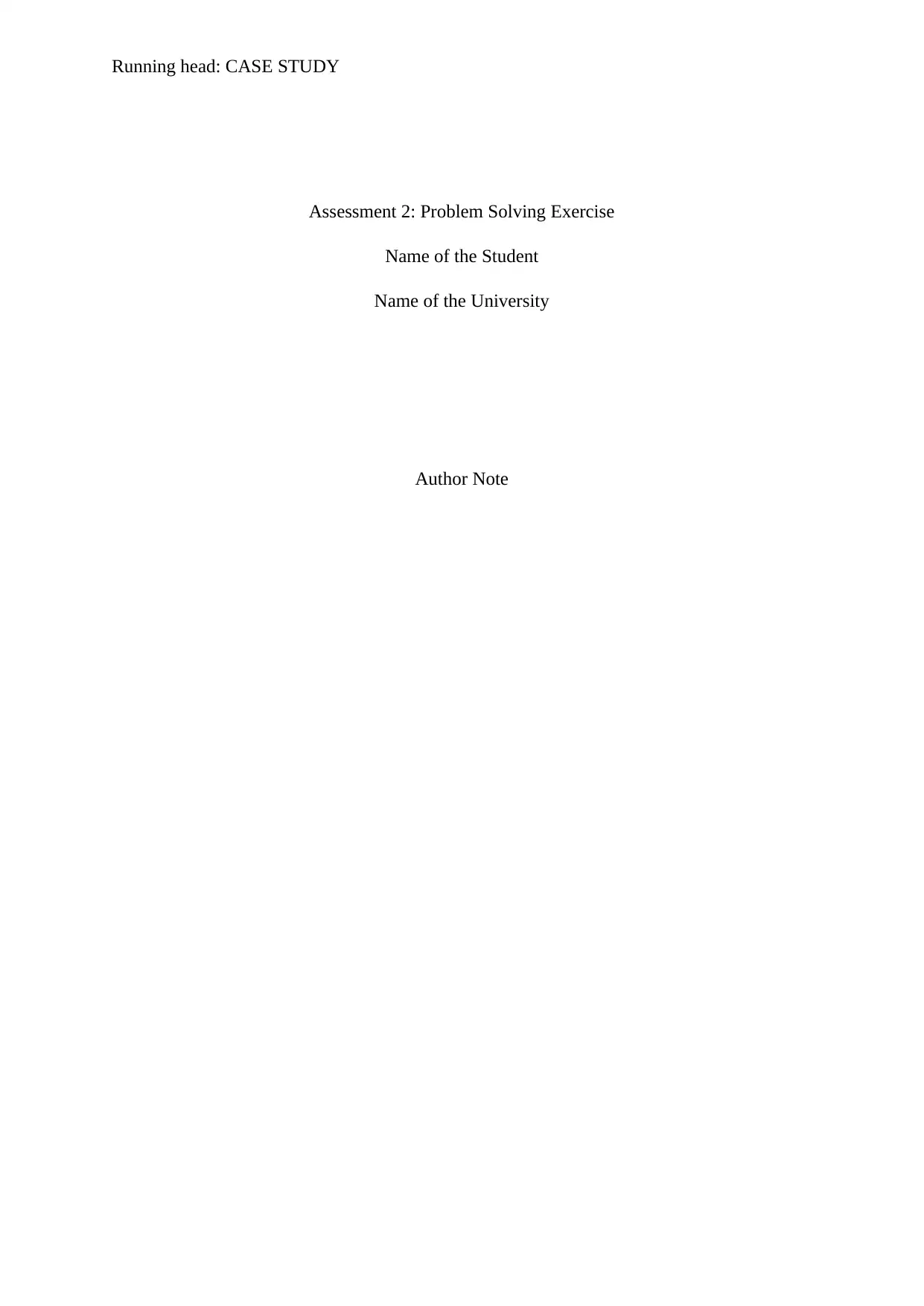
Running head: CASE STUDY
Assessment 2: Problem Solving Exercise
Name of the Student
Name of the University
Author Note
Assessment 2: Problem Solving Exercise
Name of the Student
Name of the University
Author Note
Secure Best Marks with AI Grader
Need help grading? Try our AI Grader for instant feedback on your assignments.
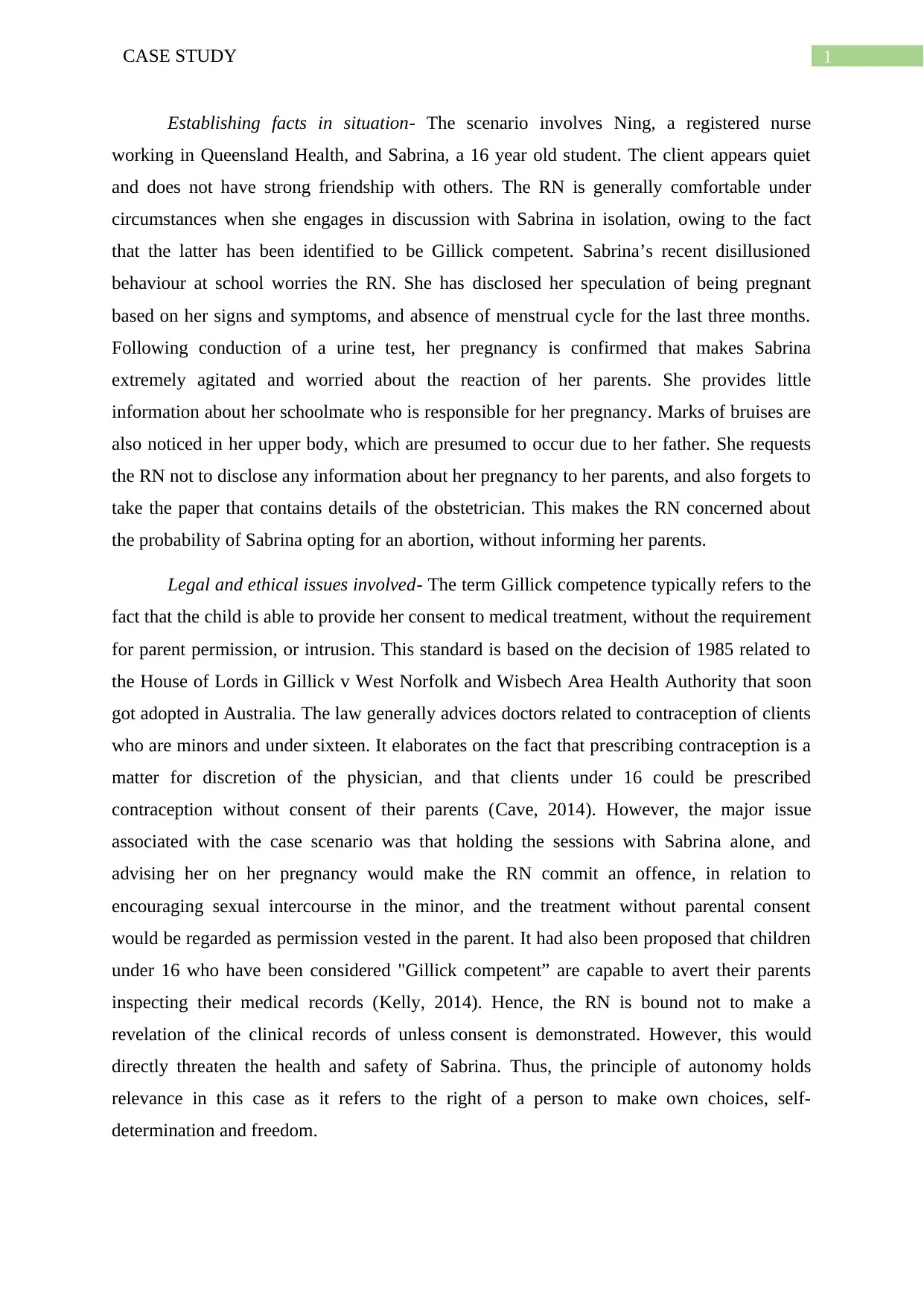
1CASE STUDY
Establishing facts in situation- The scenario involves Ning, a registered nurse
working in Queensland Health, and Sabrina, a 16 year old student. The client appears quiet
and does not have strong friendship with others. The RN is generally comfortable under
circumstances when she engages in discussion with Sabrina in isolation, owing to the fact
that the latter has been identified to be Gillick competent. Sabrina’s recent disillusioned
behaviour at school worries the RN. She has disclosed her speculation of being pregnant
based on her signs and symptoms, and absence of menstrual cycle for the last three months.
Following conduction of a urine test, her pregnancy is confirmed that makes Sabrina
extremely agitated and worried about the reaction of her parents. She provides little
information about her schoolmate who is responsible for her pregnancy. Marks of bruises are
also noticed in her upper body, which are presumed to occur due to her father. She requests
the RN not to disclose any information about her pregnancy to her parents, and also forgets to
take the paper that contains details of the obstetrician. This makes the RN concerned about
the probability of Sabrina opting for an abortion, without informing her parents.
Legal and ethical issues involved- The term Gillick competence typically refers to the
fact that the child is able to provide her consent to medical treatment, without the requirement
for parent permission, or intrusion. This standard is based on the decision of 1985 related to
the House of Lords in Gillick v West Norfolk and Wisbech Area Health Authority that soon
got adopted in Australia. The law generally advices doctors related to contraception of clients
who are minors and under sixteen. It elaborates on the fact that prescribing contraception is a
matter for discretion of the physician, and that clients under 16 could be prescribed
contraception without consent of their parents (Cave, 2014). However, the major issue
associated with the case scenario was that holding the sessions with Sabrina alone, and
advising her on her pregnancy would make the RN commit an offence, in relation to
encouraging sexual intercourse in the minor, and the treatment without parental consent
would be regarded as permission vested in the parent. It had also been proposed that children
under 16 who have been considered "Gillick competent” are capable to avert their parents
inspecting their medical records (Kelly, 2014). Hence, the RN is bound not to make a
revelation of the clinical records of unless consent is demonstrated. However, this would
directly threaten the health and safety of Sabrina. Thus, the principle of autonomy holds
relevance in this case as it refers to the right of a person to make own choices, self-
determination and freedom.
Establishing facts in situation- The scenario involves Ning, a registered nurse
working in Queensland Health, and Sabrina, a 16 year old student. The client appears quiet
and does not have strong friendship with others. The RN is generally comfortable under
circumstances when she engages in discussion with Sabrina in isolation, owing to the fact
that the latter has been identified to be Gillick competent. Sabrina’s recent disillusioned
behaviour at school worries the RN. She has disclosed her speculation of being pregnant
based on her signs and symptoms, and absence of menstrual cycle for the last three months.
Following conduction of a urine test, her pregnancy is confirmed that makes Sabrina
extremely agitated and worried about the reaction of her parents. She provides little
information about her schoolmate who is responsible for her pregnancy. Marks of bruises are
also noticed in her upper body, which are presumed to occur due to her father. She requests
the RN not to disclose any information about her pregnancy to her parents, and also forgets to
take the paper that contains details of the obstetrician. This makes the RN concerned about
the probability of Sabrina opting for an abortion, without informing her parents.
Legal and ethical issues involved- The term Gillick competence typically refers to the
fact that the child is able to provide her consent to medical treatment, without the requirement
for parent permission, or intrusion. This standard is based on the decision of 1985 related to
the House of Lords in Gillick v West Norfolk and Wisbech Area Health Authority that soon
got adopted in Australia. The law generally advices doctors related to contraception of clients
who are minors and under sixteen. It elaborates on the fact that prescribing contraception is a
matter for discretion of the physician, and that clients under 16 could be prescribed
contraception without consent of their parents (Cave, 2014). However, the major issue
associated with the case scenario was that holding the sessions with Sabrina alone, and
advising her on her pregnancy would make the RN commit an offence, in relation to
encouraging sexual intercourse in the minor, and the treatment without parental consent
would be regarded as permission vested in the parent. It had also been proposed that children
under 16 who have been considered "Gillick competent” are capable to avert their parents
inspecting their medical records (Kelly, 2014). Hence, the RN is bound not to make a
revelation of the clinical records of unless consent is demonstrated. However, this would
directly threaten the health and safety of Sabrina. Thus, the principle of autonomy holds
relevance in this case as it refers to the right of a person to make own choices, self-
determination and freedom.
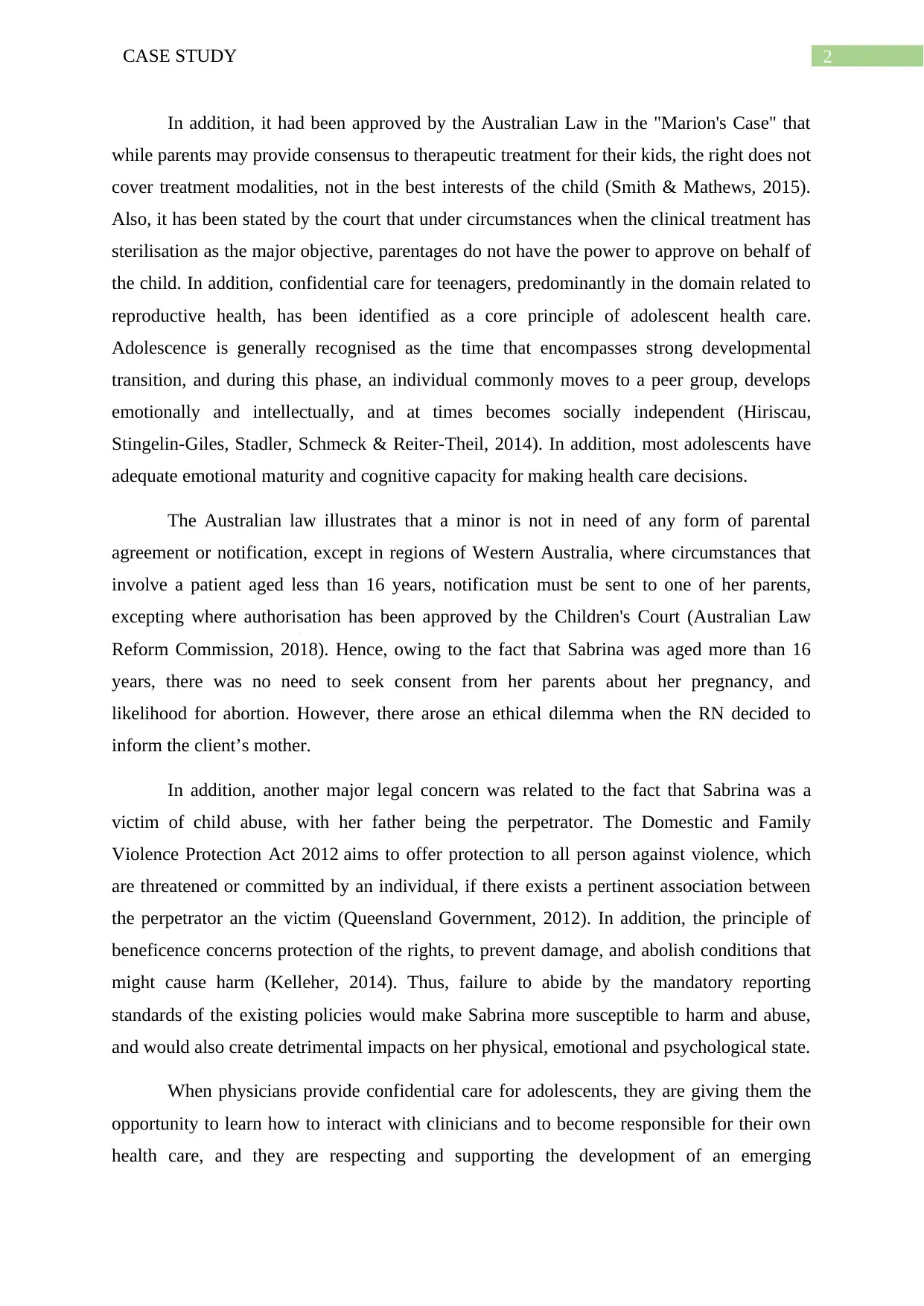
2CASE STUDY
In addition, it had been approved by the Australian Law in the "Marion's Case" that
while parents may provide consensus to therapeutic treatment for their kids, the right does not
cover treatment modalities, not in the best interests of the child (Smith & Mathews, 2015).
Also, it has been stated by the court that under circumstances when the clinical treatment has
sterilisation as the major objective, parentages do not have the power to approve on behalf of
the child. In addition, confidential care for teenagers, predominantly in the domain related to
reproductive health, has been identified as a core principle of adolescent health care.
Adolescence is generally recognised as the time that encompasses strong developmental
transition, and during this phase, an individual commonly moves to a peer group, develops
emotionally and intellectually, and at times becomes socially independent (Hiriscau,
Stingelin-Giles, Stadler, Schmeck & Reiter-Theil, 2014). In addition, most adolescents have
adequate emotional maturity and cognitive capacity for making health care decisions.
The Australian law illustrates that a minor is not in need of any form of parental
agreement or notification, except in regions of Western Australia, where circumstances that
involve a patient aged less than 16 years, notification must be sent to one of her parents,
excepting where authorisation has been approved by the Children's Court (Australian Law
Reform Commission, 2018). Hence, owing to the fact that Sabrina was aged more than 16
years, there was no need to seek consent from her parents about her pregnancy, and
likelihood for abortion. However, there arose an ethical dilemma when the RN decided to
inform the client’s mother.
In addition, another major legal concern was related to the fact that Sabrina was a
victim of child abuse, with her father being the perpetrator. The Domestic and Family
Violence Protection Act 2012 aims to offer protection to all person against violence, which
are threatened or committed by an individual, if there exists a pertinent association between
the perpetrator an the victim (Queensland Government, 2012). In addition, the principle of
beneficence concerns protection of the rights, to prevent damage, and abolish conditions that
might cause harm (Kelleher, 2014). Thus, failure to abide by the mandatory reporting
standards of the existing policies would make Sabrina more susceptible to harm and abuse,
and would also create detrimental impacts on her physical, emotional and psychological state.
When physicians provide confidential care for adolescents, they are giving them the
opportunity to learn how to interact with clinicians and to become responsible for their own
health care, and they are respecting and supporting the development of an emerging
In addition, it had been approved by the Australian Law in the "Marion's Case" that
while parents may provide consensus to therapeutic treatment for their kids, the right does not
cover treatment modalities, not in the best interests of the child (Smith & Mathews, 2015).
Also, it has been stated by the court that under circumstances when the clinical treatment has
sterilisation as the major objective, parentages do not have the power to approve on behalf of
the child. In addition, confidential care for teenagers, predominantly in the domain related to
reproductive health, has been identified as a core principle of adolescent health care.
Adolescence is generally recognised as the time that encompasses strong developmental
transition, and during this phase, an individual commonly moves to a peer group, develops
emotionally and intellectually, and at times becomes socially independent (Hiriscau,
Stingelin-Giles, Stadler, Schmeck & Reiter-Theil, 2014). In addition, most adolescents have
adequate emotional maturity and cognitive capacity for making health care decisions.
The Australian law illustrates that a minor is not in need of any form of parental
agreement or notification, except in regions of Western Australia, where circumstances that
involve a patient aged less than 16 years, notification must be sent to one of her parents,
excepting where authorisation has been approved by the Children's Court (Australian Law
Reform Commission, 2018). Hence, owing to the fact that Sabrina was aged more than 16
years, there was no need to seek consent from her parents about her pregnancy, and
likelihood for abortion. However, there arose an ethical dilemma when the RN decided to
inform the client’s mother.
In addition, another major legal concern was related to the fact that Sabrina was a
victim of child abuse, with her father being the perpetrator. The Domestic and Family
Violence Protection Act 2012 aims to offer protection to all person against violence, which
are threatened or committed by an individual, if there exists a pertinent association between
the perpetrator an the victim (Queensland Government, 2012). In addition, the principle of
beneficence concerns protection of the rights, to prevent damage, and abolish conditions that
might cause harm (Kelleher, 2014). Thus, failure to abide by the mandatory reporting
standards of the existing policies would make Sabrina more susceptible to harm and abuse,
and would also create detrimental impacts on her physical, emotional and psychological state.
When physicians provide confidential care for adolescents, they are giving them the
opportunity to learn how to interact with clinicians and to become responsible for their own
health care, and they are respecting and supporting the development of an emerging
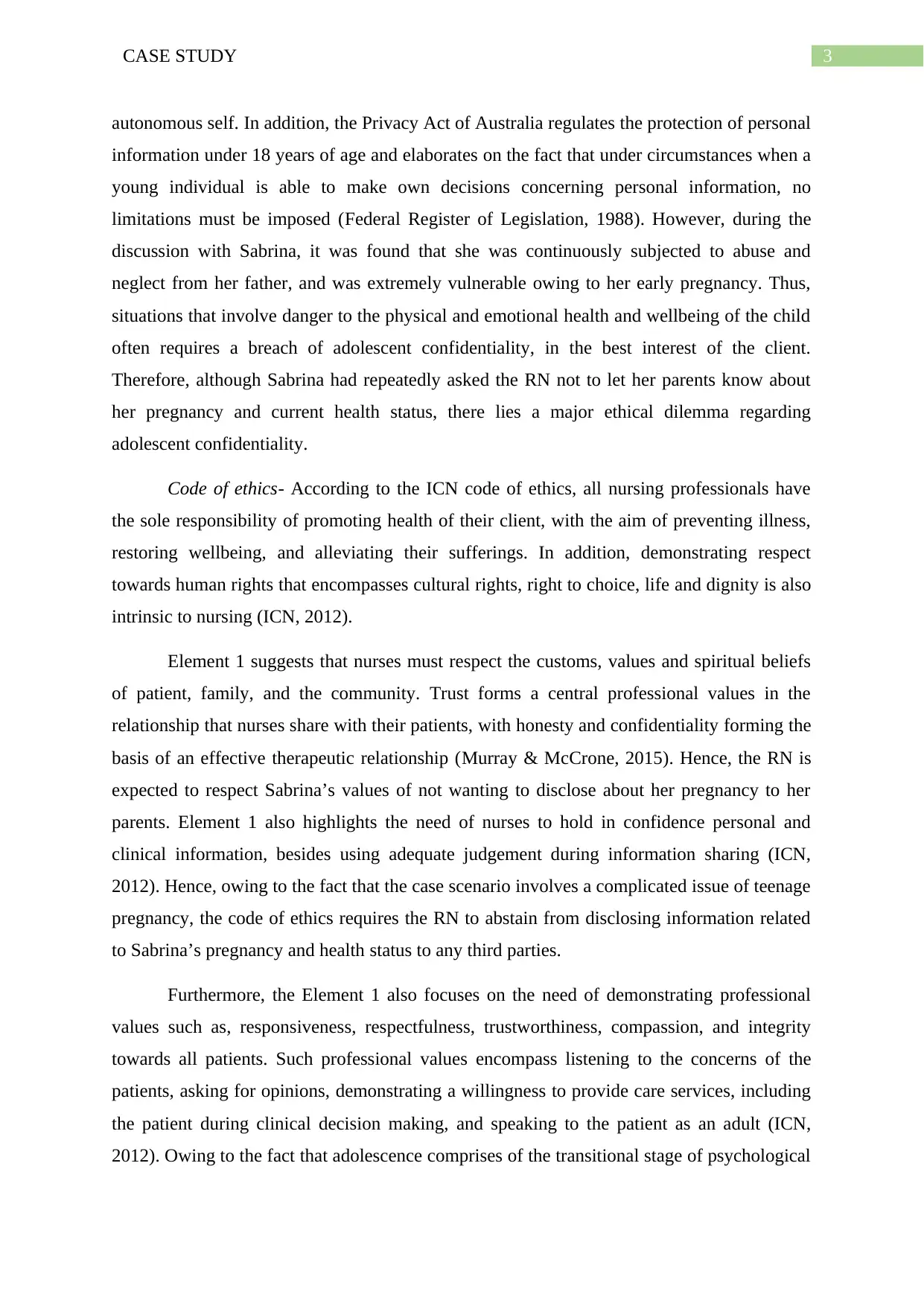
3CASE STUDY
autonomous self. In addition, the Privacy Act of Australia regulates the protection of personal
information under 18 years of age and elaborates on the fact that under circumstances when a
young individual is able to make own decisions concerning personal information, no
limitations must be imposed (Federal Register of Legislation, 1988). However, during the
discussion with Sabrina, it was found that she was continuously subjected to abuse and
neglect from her father, and was extremely vulnerable owing to her early pregnancy. Thus,
situations that involve danger to the physical and emotional health and wellbeing of the child
often requires a breach of adolescent confidentiality, in the best interest of the client.
Therefore, although Sabrina had repeatedly asked the RN not to let her parents know about
her pregnancy and current health status, there lies a major ethical dilemma regarding
adolescent confidentiality.
Code of ethics- According to the ICN code of ethics, all nursing professionals have
the sole responsibility of promoting health of their client, with the aim of preventing illness,
restoring wellbeing, and alleviating their sufferings. In addition, demonstrating respect
towards human rights that encompasses cultural rights, right to choice, life and dignity is also
intrinsic to nursing (ICN, 2012).
Element 1 suggests that nurses must respect the customs, values and spiritual beliefs
of patient, family, and the community. Trust forms a central professional values in the
relationship that nurses share with their patients, with honesty and confidentiality forming the
basis of an effective therapeutic relationship (Murray & McCrone, 2015). Hence, the RN is
expected to respect Sabrina’s values of not wanting to disclose about her pregnancy to her
parents. Element 1 also highlights the need of nurses to hold in confidence personal and
clinical information, besides using adequate judgement during information sharing (ICN,
2012). Hence, owing to the fact that the case scenario involves a complicated issue of teenage
pregnancy, the code of ethics requires the RN to abstain from disclosing information related
to Sabrina’s pregnancy and health status to any third parties.
Furthermore, the Element 1 also focuses on the need of demonstrating professional
values such as, responsiveness, respectfulness, trustworthiness, compassion, and integrity
towards all patients. Such professional values encompass listening to the concerns of the
patients, asking for opinions, demonstrating a willingness to provide care services, including
the patient during clinical decision making, and speaking to the patient as an adult (ICN,
2012). Owing to the fact that adolescence comprises of the transitional stage of psychological
autonomous self. In addition, the Privacy Act of Australia regulates the protection of personal
information under 18 years of age and elaborates on the fact that under circumstances when a
young individual is able to make own decisions concerning personal information, no
limitations must be imposed (Federal Register of Legislation, 1988). However, during the
discussion with Sabrina, it was found that she was continuously subjected to abuse and
neglect from her father, and was extremely vulnerable owing to her early pregnancy. Thus,
situations that involve danger to the physical and emotional health and wellbeing of the child
often requires a breach of adolescent confidentiality, in the best interest of the client.
Therefore, although Sabrina had repeatedly asked the RN not to let her parents know about
her pregnancy and current health status, there lies a major ethical dilemma regarding
adolescent confidentiality.
Code of ethics- According to the ICN code of ethics, all nursing professionals have
the sole responsibility of promoting health of their client, with the aim of preventing illness,
restoring wellbeing, and alleviating their sufferings. In addition, demonstrating respect
towards human rights that encompasses cultural rights, right to choice, life and dignity is also
intrinsic to nursing (ICN, 2012).
Element 1 suggests that nurses must respect the customs, values and spiritual beliefs
of patient, family, and the community. Trust forms a central professional values in the
relationship that nurses share with their patients, with honesty and confidentiality forming the
basis of an effective therapeutic relationship (Murray & McCrone, 2015). Hence, the RN is
expected to respect Sabrina’s values of not wanting to disclose about her pregnancy to her
parents. Element 1 also highlights the need of nurses to hold in confidence personal and
clinical information, besides using adequate judgement during information sharing (ICN,
2012). Hence, owing to the fact that the case scenario involves a complicated issue of teenage
pregnancy, the code of ethics requires the RN to abstain from disclosing information related
to Sabrina’s pregnancy and health status to any third parties.
Furthermore, the Element 1 also focuses on the need of demonstrating professional
values such as, responsiveness, respectfulness, trustworthiness, compassion, and integrity
towards all patients. Such professional values encompass listening to the concerns of the
patients, asking for opinions, demonstrating a willingness to provide care services, including
the patient during clinical decision making, and speaking to the patient as an adult (ICN,
2012). Owing to the fact that adolescence comprises of the transitional stage of psychological
Secure Best Marks with AI Grader
Need help grading? Try our AI Grader for instant feedback on your assignments.
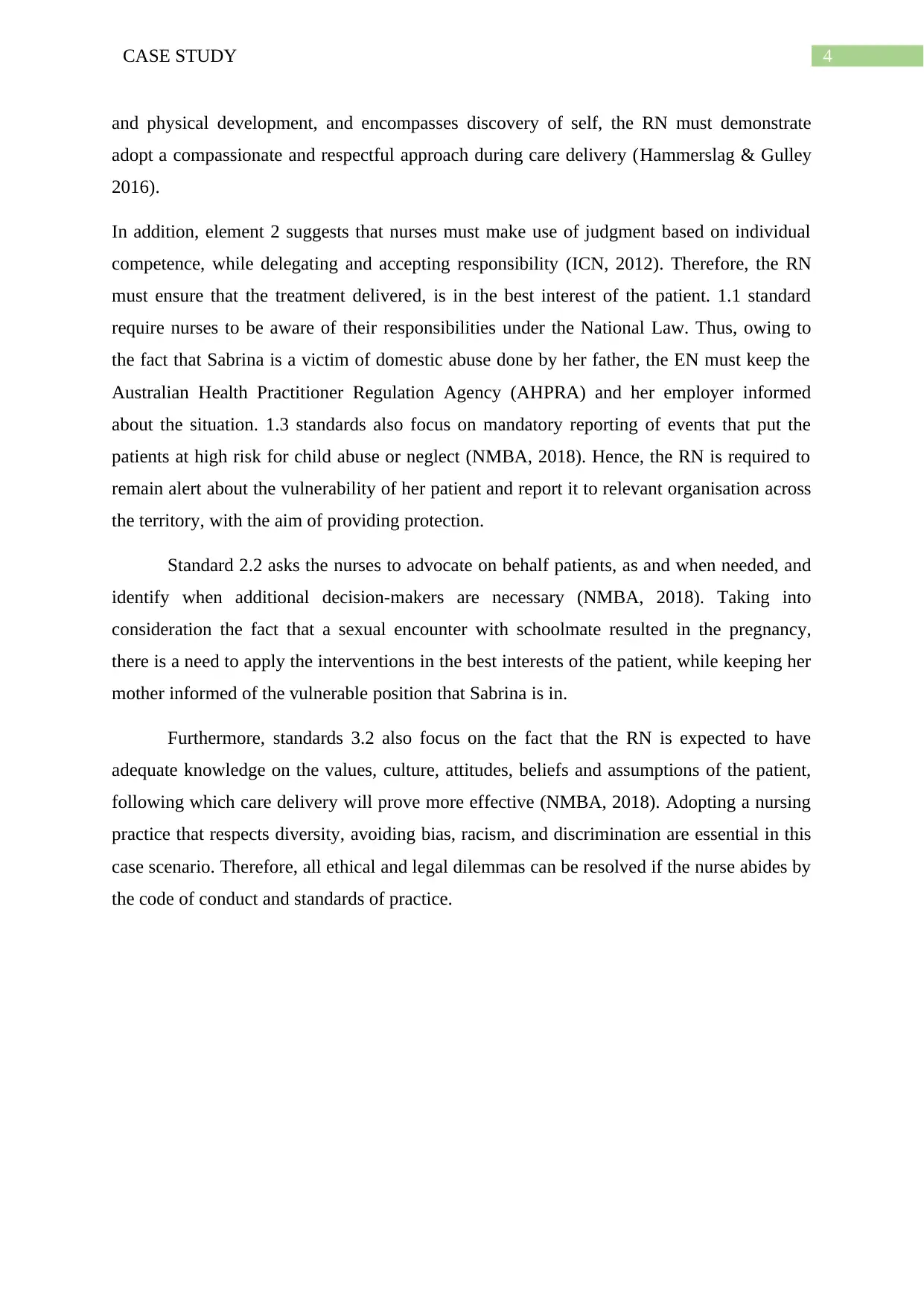
4CASE STUDY
and physical development, and encompasses discovery of self, the RN must demonstrate
adopt a compassionate and respectful approach during care delivery (Hammerslag & Gulley
2016).
In addition, element 2 suggests that nurses must make use of judgment based on individual
competence, while delegating and accepting responsibility (ICN, 2012). Therefore, the RN
must ensure that the treatment delivered, is in the best interest of the patient. 1.1 standard
require nurses to be aware of their responsibilities under the National Law. Thus, owing to
the fact that Sabrina is a victim of domestic abuse done by her father, the EN must keep the
Australian Health Practitioner Regulation Agency (AHPRA) and her employer informed
about the situation. 1.3 standards also focus on mandatory reporting of events that put the
patients at high risk for child abuse or neglect (NMBA, 2018). Hence, the RN is required to
remain alert about the vulnerability of her patient and report it to relevant organisation across
the territory, with the aim of providing protection.
Standard 2.2 asks the nurses to advocate on behalf patients, as and when needed, and
identify when additional decision-makers are necessary (NMBA, 2018). Taking into
consideration the fact that a sexual encounter with schoolmate resulted in the pregnancy,
there is a need to apply the interventions in the best interests of the patient, while keeping her
mother informed of the vulnerable position that Sabrina is in.
Furthermore, standards 3.2 also focus on the fact that the RN is expected to have
adequate knowledge on the values, culture, attitudes, beliefs and assumptions of the patient,
following which care delivery will prove more effective (NMBA, 2018). Adopting a nursing
practice that respects diversity, avoiding bias, racism, and discrimination are essential in this
case scenario. Therefore, all ethical and legal dilemmas can be resolved if the nurse abides by
the code of conduct and standards of practice.
and physical development, and encompasses discovery of self, the RN must demonstrate
adopt a compassionate and respectful approach during care delivery (Hammerslag & Gulley
2016).
In addition, element 2 suggests that nurses must make use of judgment based on individual
competence, while delegating and accepting responsibility (ICN, 2012). Therefore, the RN
must ensure that the treatment delivered, is in the best interest of the patient. 1.1 standard
require nurses to be aware of their responsibilities under the National Law. Thus, owing to
the fact that Sabrina is a victim of domestic abuse done by her father, the EN must keep the
Australian Health Practitioner Regulation Agency (AHPRA) and her employer informed
about the situation. 1.3 standards also focus on mandatory reporting of events that put the
patients at high risk for child abuse or neglect (NMBA, 2018). Hence, the RN is required to
remain alert about the vulnerability of her patient and report it to relevant organisation across
the territory, with the aim of providing protection.
Standard 2.2 asks the nurses to advocate on behalf patients, as and when needed, and
identify when additional decision-makers are necessary (NMBA, 2018). Taking into
consideration the fact that a sexual encounter with schoolmate resulted in the pregnancy,
there is a need to apply the interventions in the best interests of the patient, while keeping her
mother informed of the vulnerable position that Sabrina is in.
Furthermore, standards 3.2 also focus on the fact that the RN is expected to have
adequate knowledge on the values, culture, attitudes, beliefs and assumptions of the patient,
following which care delivery will prove more effective (NMBA, 2018). Adopting a nursing
practice that respects diversity, avoiding bias, racism, and discrimination are essential in this
case scenario. Therefore, all ethical and legal dilemmas can be resolved if the nurse abides by
the code of conduct and standards of practice.
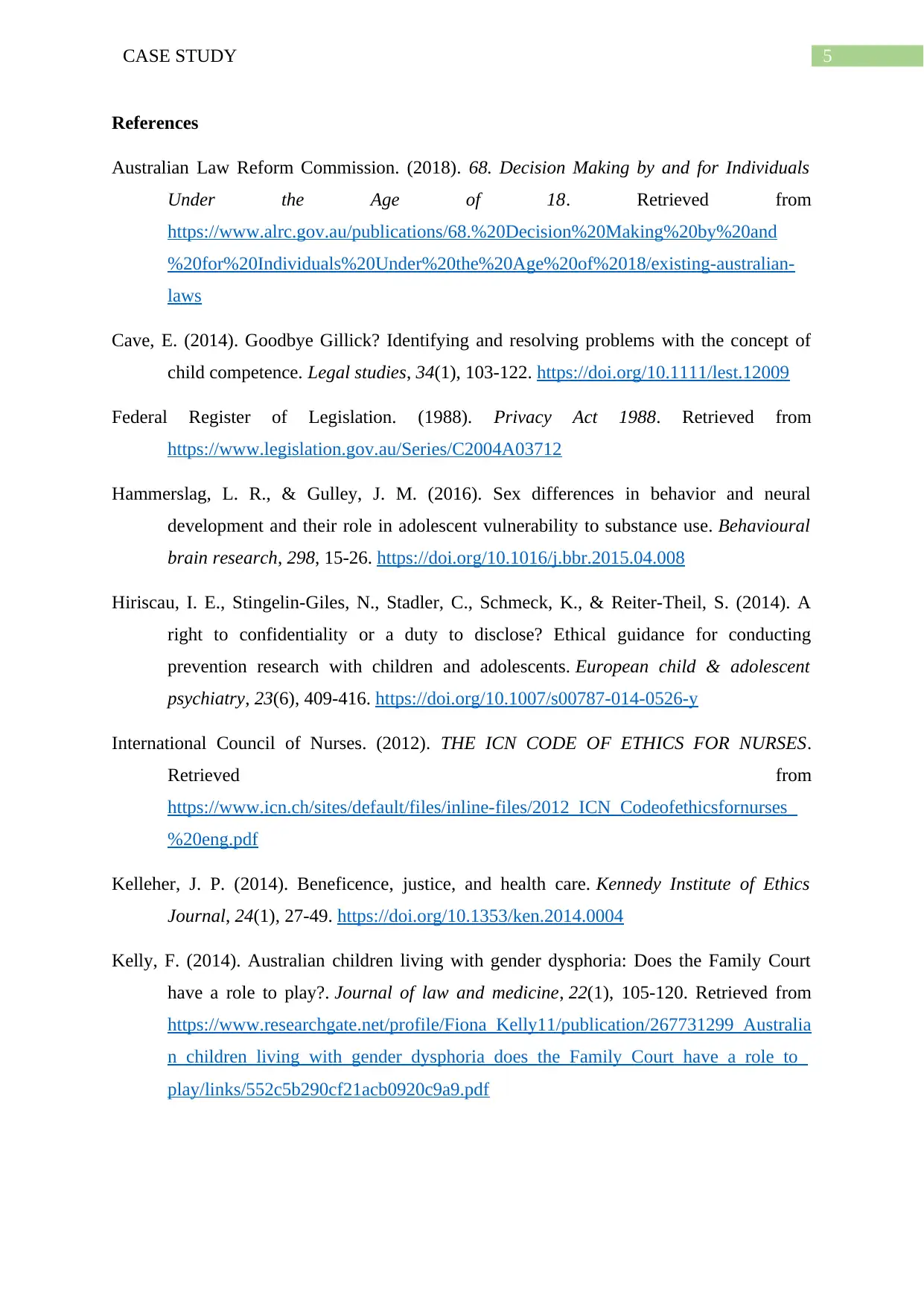
5CASE STUDY
References
Australian Law Reform Commission. (2018). 68. Decision Making by and for Individuals
Under the Age of 18. Retrieved from
https://www.alrc.gov.au/publications/68.%20Decision%20Making%20by%20and
%20for%20Individuals%20Under%20the%20Age%20of%2018/existing-australian-
laws
Cave, E. (2014). Goodbye Gillick? Identifying and resolving problems with the concept of
child competence. Legal studies, 34(1), 103-122. https://doi.org/10.1111/lest.12009
Federal Register of Legislation. (1988). Privacy Act 1988. Retrieved from
https://www.legislation.gov.au/Series/C2004A03712
Hammerslag, L. R., & Gulley, J. M. (2016). Sex differences in behavior and neural
development and their role in adolescent vulnerability to substance use. Behavioural
brain research, 298, 15-26. https://doi.org/10.1016/j.bbr.2015.04.008
Hiriscau, I. E., Stingelin-Giles, N., Stadler, C., Schmeck, K., & Reiter-Theil, S. (2014). A
right to confidentiality or a duty to disclose? Ethical guidance for conducting
prevention research with children and adolescents. European child & adolescent
psychiatry, 23(6), 409-416. https://doi.org/10.1007/s00787-014-0526-y
International Council of Nurses. (2012). THE ICN CODE OF ETHICS FOR NURSES.
Retrieved from
https://www.icn.ch/sites/default/files/inline-files/2012_ICN_Codeofethicsfornurses_
%20eng.pdf
Kelleher, J. P. (2014). Beneficence, justice, and health care. Kennedy Institute of Ethics
Journal, 24(1), 27-49. https://doi.org/10.1353/ken.2014.0004
Kelly, F. (2014). Australian children living with gender dysphoria: Does the Family Court
have a role to play?. Journal of law and medicine, 22(1), 105-120. Retrieved from
https://www.researchgate.net/profile/Fiona_Kelly11/publication/267731299_Australia
n_children_living_with_gender_dysphoria_does_the_Family_Court_have_a_role_to_
play/links/552c5b290cf21acb0920c9a9.pdf
References
Australian Law Reform Commission. (2018). 68. Decision Making by and for Individuals
Under the Age of 18. Retrieved from
https://www.alrc.gov.au/publications/68.%20Decision%20Making%20by%20and
%20for%20Individuals%20Under%20the%20Age%20of%2018/existing-australian-
laws
Cave, E. (2014). Goodbye Gillick? Identifying and resolving problems with the concept of
child competence. Legal studies, 34(1), 103-122. https://doi.org/10.1111/lest.12009
Federal Register of Legislation. (1988). Privacy Act 1988. Retrieved from
https://www.legislation.gov.au/Series/C2004A03712
Hammerslag, L. R., & Gulley, J. M. (2016). Sex differences in behavior and neural
development and their role in adolescent vulnerability to substance use. Behavioural
brain research, 298, 15-26. https://doi.org/10.1016/j.bbr.2015.04.008
Hiriscau, I. E., Stingelin-Giles, N., Stadler, C., Schmeck, K., & Reiter-Theil, S. (2014). A
right to confidentiality or a duty to disclose? Ethical guidance for conducting
prevention research with children and adolescents. European child & adolescent
psychiatry, 23(6), 409-416. https://doi.org/10.1007/s00787-014-0526-y
International Council of Nurses. (2012). THE ICN CODE OF ETHICS FOR NURSES.
Retrieved from
https://www.icn.ch/sites/default/files/inline-files/2012_ICN_Codeofethicsfornurses_
%20eng.pdf
Kelleher, J. P. (2014). Beneficence, justice, and health care. Kennedy Institute of Ethics
Journal, 24(1), 27-49. https://doi.org/10.1353/ken.2014.0004
Kelly, F. (2014). Australian children living with gender dysphoria: Does the Family Court
have a role to play?. Journal of law and medicine, 22(1), 105-120. Retrieved from
https://www.researchgate.net/profile/Fiona_Kelly11/publication/267731299_Australia
n_children_living_with_gender_dysphoria_does_the_Family_Court_have_a_role_to_
play/links/552c5b290cf21acb0920c9a9.pdf
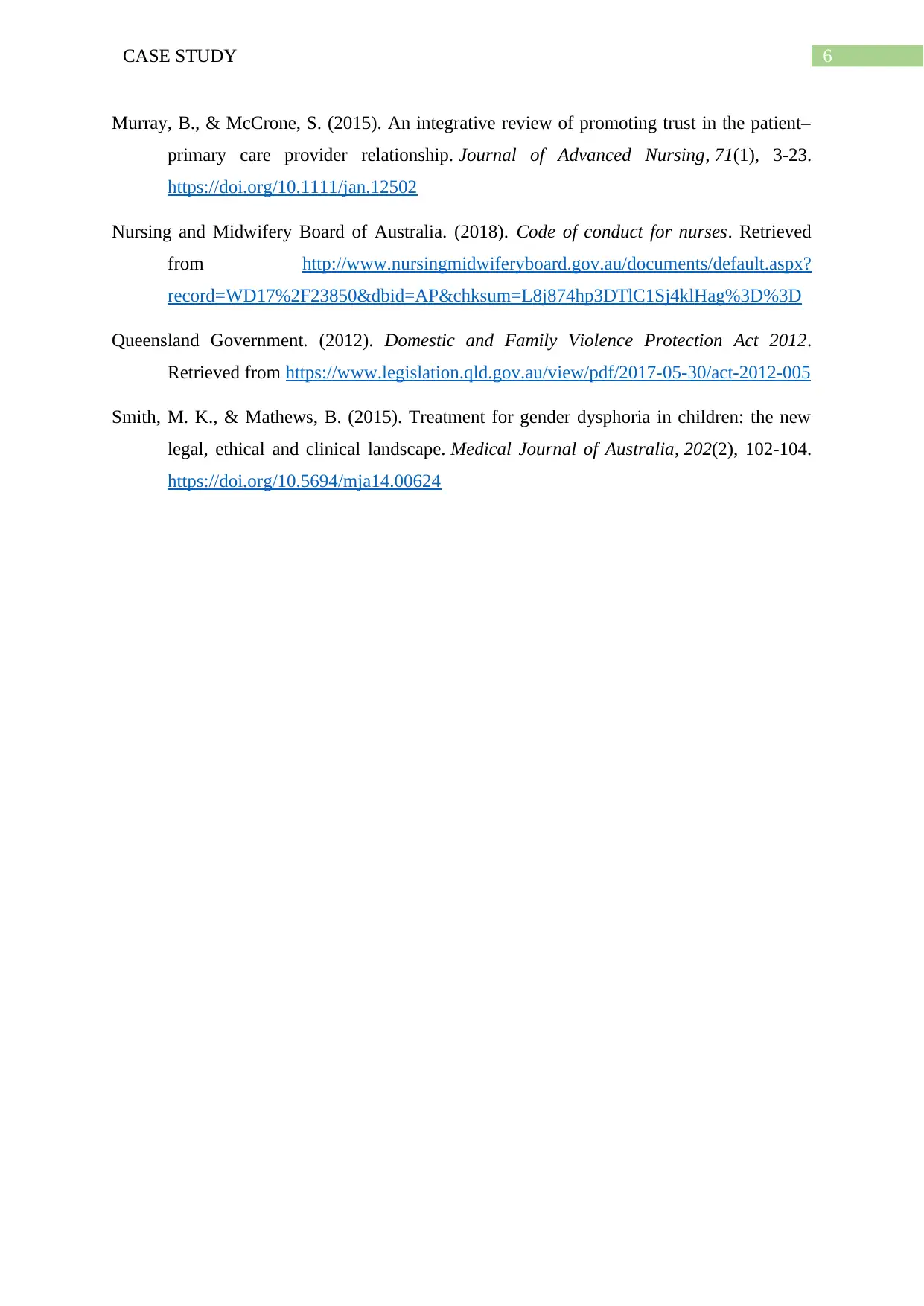
6CASE STUDY
Murray, B., & McCrone, S. (2015). An integrative review of promoting trust in the patient–
primary care provider relationship. Journal of Advanced Nursing, 71(1), 3-23.
https://doi.org/10.1111/jan.12502
Nursing and Midwifery Board of Australia. (2018). Code of conduct for nurses. Retrieved
from http://www.nursingmidwiferyboard.gov.au/documents/default.aspx?
record=WD17%2F23850&dbid=AP&chksum=L8j874hp3DTlC1Sj4klHag%3D%3D
Queensland Government. (2012). Domestic and Family Violence Protection Act 2012.
Retrieved from https://www.legislation.qld.gov.au/view/pdf/2017-05-30/act-2012-005
Smith, M. K., & Mathews, B. (2015). Treatment for gender dysphoria in children: the new
legal, ethical and clinical landscape. Medical Journal of Australia, 202(2), 102-104.
https://doi.org/10.5694/mja14.00624
Murray, B., & McCrone, S. (2015). An integrative review of promoting trust in the patient–
primary care provider relationship. Journal of Advanced Nursing, 71(1), 3-23.
https://doi.org/10.1111/jan.12502
Nursing and Midwifery Board of Australia. (2018). Code of conduct for nurses. Retrieved
from http://www.nursingmidwiferyboard.gov.au/documents/default.aspx?
record=WD17%2F23850&dbid=AP&chksum=L8j874hp3DTlC1Sj4klHag%3D%3D
Queensland Government. (2012). Domestic and Family Violence Protection Act 2012.
Retrieved from https://www.legislation.qld.gov.au/view/pdf/2017-05-30/act-2012-005
Smith, M. K., & Mathews, B. (2015). Treatment for gender dysphoria in children: the new
legal, ethical and clinical landscape. Medical Journal of Australia, 202(2), 102-104.
https://doi.org/10.5694/mja14.00624
1 out of 7
Related Documents
Your All-in-One AI-Powered Toolkit for Academic Success.
+13062052269
info@desklib.com
Available 24*7 on WhatsApp / Email
![[object Object]](/_next/static/media/star-bottom.7253800d.svg)
Unlock your academic potential
© 2024 | Zucol Services PVT LTD | All rights reserved.





